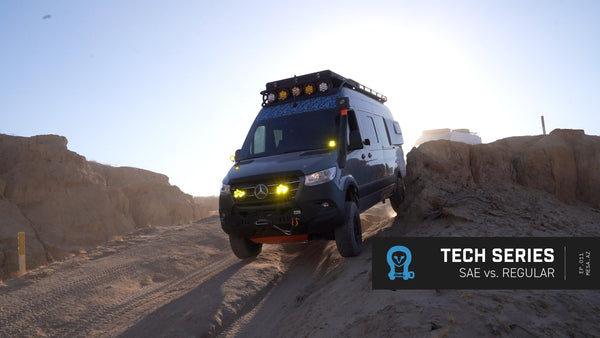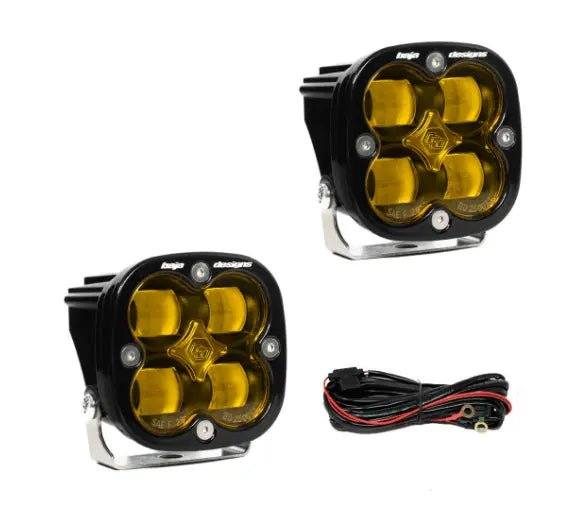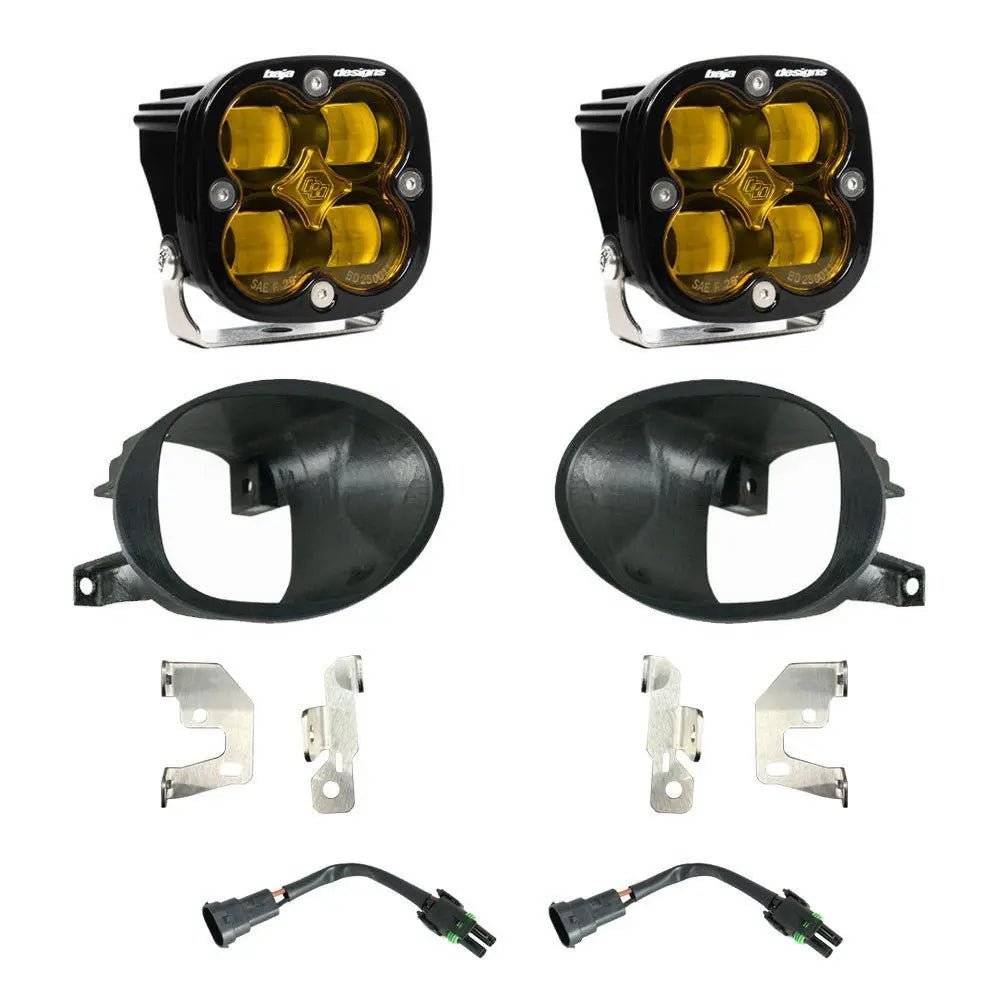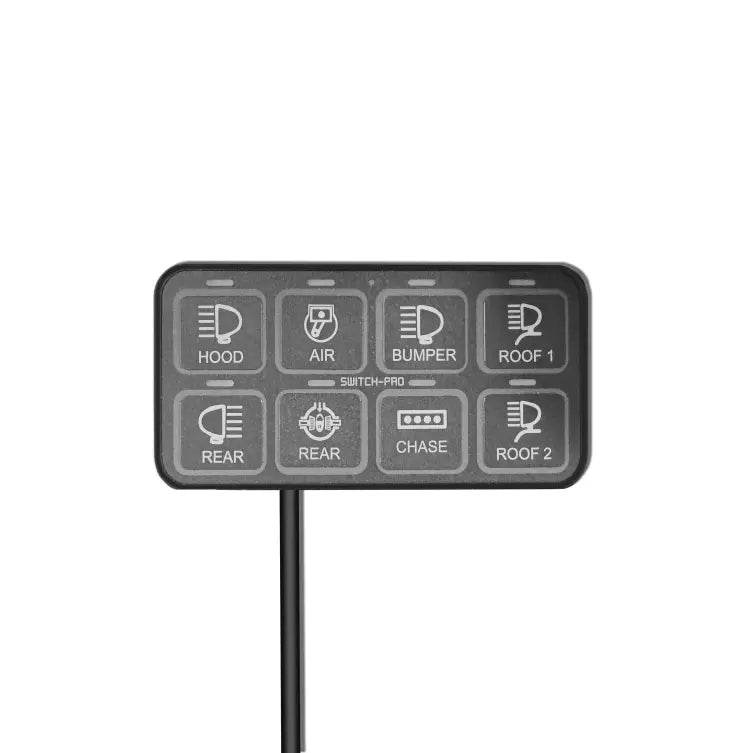Tech Series Filter
Owl Sprinter Van Tech Series: SAE vs Off-Road Lighting
Lighting upgrades are some of the most impactful modifications you can make to your Sprinter Van or INEOS Grenadier. Whether you’re carving your own path on remote trails or cruising the interstate en route to your next adventure, choosing the right auxiliary lighting is about more than brightness. You also have to consider legality, function, and safety.
At Owl, we sweat the details so you get reliable gear and insider-level expertise. Let’s break down the essentials: SAE-compliant vs. off-road lights, clear versus amber lenses, and what those choices mean for real-world use.
The Basics: SAE-Compliant Lighting and Why It Matters
If you’ve spent any time researching van upgrades, you've likely seen lighting products labeled “SAE compliant.” But what does that mean for you?
SAE stands for Society of Automotive Engineers. When a light is SAE compliant, it means it’s DOT (Department of Transportation) approved and designed and tested to meet specific standards for use on public roads.
Key Advantages of SAE-Compliant Lights
-
Legal Road Use: You don’t need to cover up these lights while driving on highways or public roads.
-
Peace of Mind: If law enforcement checks your gear, they’ll look for SAE markings on the lens. If you’re running true SAE-compliant equipment (like the Baja Designs fog light John mentions), you’re set.
-
Easy Integration: Many SAE lights are built to fit directly into factory positions, such as replacing stock fog lights, to maintain your van’s roadworthiness.
Expert Insight: Vehicle codes in California strictly regulate auxiliary lighting and SAE compliance. If you’re running non-SAE auxiliary lights on public roads, you risk getting ticketed unless you keep those lights covered.
Off-Road Lighting: Power Where You Need It Most
When you leave the pavement, SAE certification falls by the wayside. Off-road lights are engineered for peak performance in remote environments. Here’s what matters:
-
Higher Output: Non-SAE lights often deliver higher brightness and broader spreads, perfect for trail runs after dusk or lighting up a campsite.
-
Custom Mounting: Roof racks, bull bars, and other accessory mounts are fair game for installation. These lights aren’t restricted by DOT aiming or intensity rules.
-
Versatility: Off-road lights can include spots, floods, and hybrid beams tailored for terrain navigation.
Legal Note: Non-SAE lights must be covered on highways in many states. This is more than a technicality. It’s about glare and safety for other drivers. Always check your local regulations, and be ready to use a lighting switch or snap on covers when transitioning from dirt to pavement.
SAE vs. Non-SAE: How to Determine If Your Light is Legal
How do you quickly check your compliance status? Inspect the lens.
-
SAE Markings: Road-legal lights will have “SAE” and a code (e.g., “SAE F20”) etched into the lens. This customarily confirms DOT approval.
-
Non-SAE Lights: Typically, these high-output lights lack any such imprint and are for off-road use only.
Real-world scenario: If pulled over, an officer will check for the SAE mark. No mark? You’re likely headed for a citation if those lights aren’t covered.
Clear vs. Amber Lights: Choose Your Lens for the Trail Ahead
Clear Lighting

-
Maximum Light Output: Clear lenses project the brightest beam. Use when you want maximum visibility in ideal conditions (dry, clear air).
-
Best For: Open highways, dark rural roads, or dry off-road trails.
Amber Lighting:

-
Depth Perception: Amber cuts through dust, snow, fog, and atmospheric distortion. It enhances contrast and reduces “blowout,” making it easier to perceive ground contours.
-
Best For: Snowy passes, dusty trails, rainy weather, or when driving in heavy mist.
Pro Tip from Owl: Many owners wire their clear and amber lights to separate switches. Toggle each as conditions demand for a custom lighting setup that adapts instantly.
Tying It Together: Building Your Ultimate Adventure Lighting Package
At Owl, we outfit explorers with top-tier gear like Baja Designs’ SAE-compliant fogs and high-output off-road lights, optimized for Sprinter vans and Ineos Grenadier builds. Here’s how to create a lighting system that’s both legal and trail-capable:
Quick Guide to Choosing Your Setup
-
Identify Your Driving Environment: Will you spend most of your time on highways, trailheads, or remote wilderness?
-
Check Local Regulations: Prioritize SAE-compliant lighting for primary on-road use. Use off-road setups with covers or switches for compliance.
-
Mix and Match: Mount both clear and amber lights. Wire them independently for instant adaptation.
-
Look for Proven Brands: The best upgrades are those engineered for reliability and compliance — like the Baja Designs Squadron Series, available through Owl.
-
Professional Installation: Ensure clean wiring, proper aiming, and seamless switch integration for total control without fuss.
Lighting Done Right With Owl
Choosing the right lighting for your van is about more than just illumination. It’s about designing smart systems that adapt to any terrain and keep you legal wherever you roam. SAE-compliant lights deliver peace of mind on the highway, while off-road setups unlock the full potential of night-time exploration. Experienced owners equip both and know when to switch.
Ready to upgrade your Sprinter van or INEOS Grenadier with the ultimate blend of legal, high-performance lighting? Check out our products and talk to real experts who adventure as hard as you do. Get outfitted for any road, any trail, any condition.
Frequently Asked Questions
Do SAE lights reduce glare for oncoming drivers?
Yes, SAE-compliant lights are designed to meet specific beam patterns and brightness standards, which help minimize glare for oncoming drivers. Properly aimed SAE lights improve visibility without blinding others on the road.
Are there SAE lights designed specifically for Mercedes Sprinter vans?
Yes, several manufacturers like Baja Designs offer SAE-certified auxiliary lights specifically built to fit Mercedes Sprinter vans. These lights are designed to match the van’s mounting points and electrical system while remaining street-legal.
What are the penalties for using non-SAE lights on highways?
Using non-SAE-approved lights can result in fines, citations, or being required to remove the lights if they don’t meet road safety standards. Enforcement varies by state.








